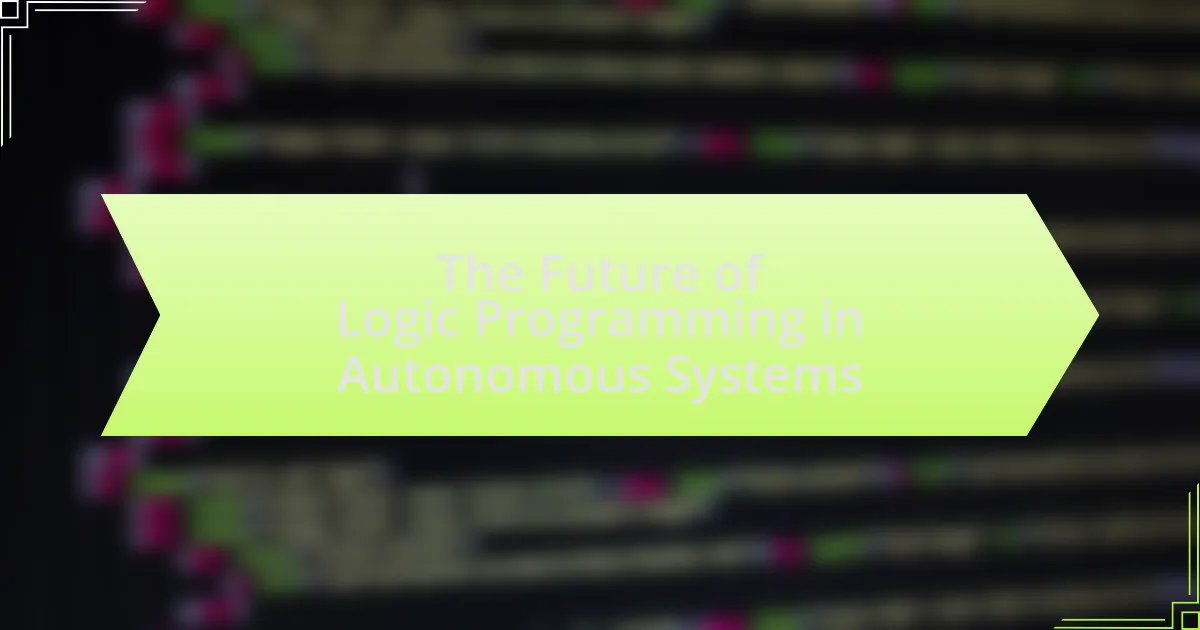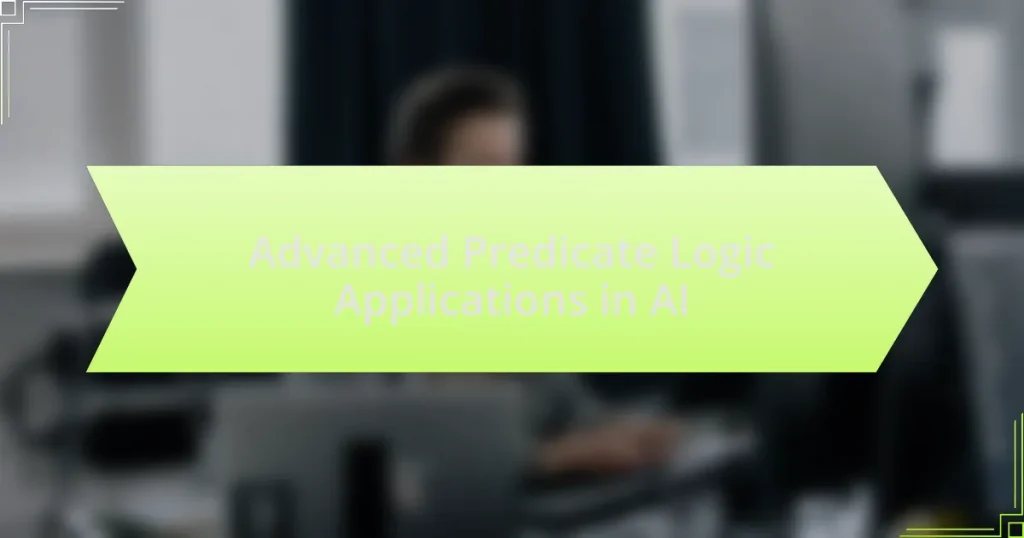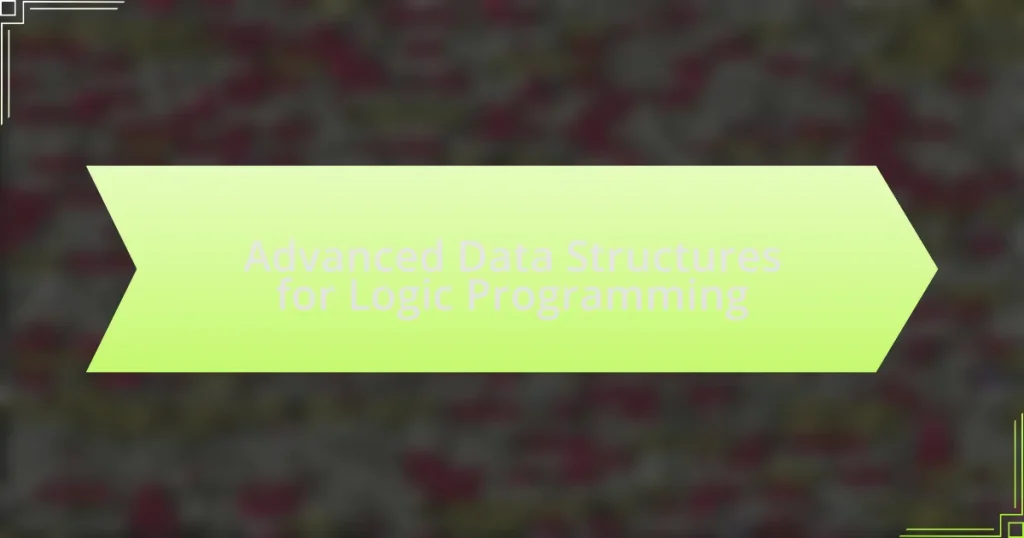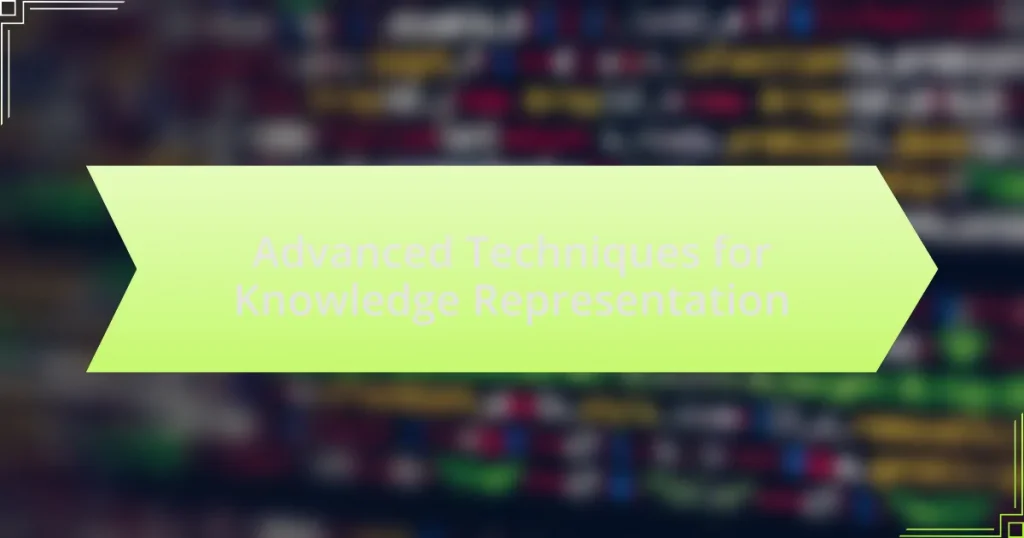The article focuses on the future of logic programming in autonomous systems, emphasizing its role in enhancing decision-making capabilities and system reliability. It explores how logic programming integrates with machine learning to create adaptable and intelligent systems, particularly in applications such as self-driving cars and drones. Key advancements, challenges, and ethical considerations surrounding the implementation of logic programming in various industries, including automotive and robotics, are discussed. The article also highlights best practices for successful integration and the implications of these technologies for the development of autonomous systems.
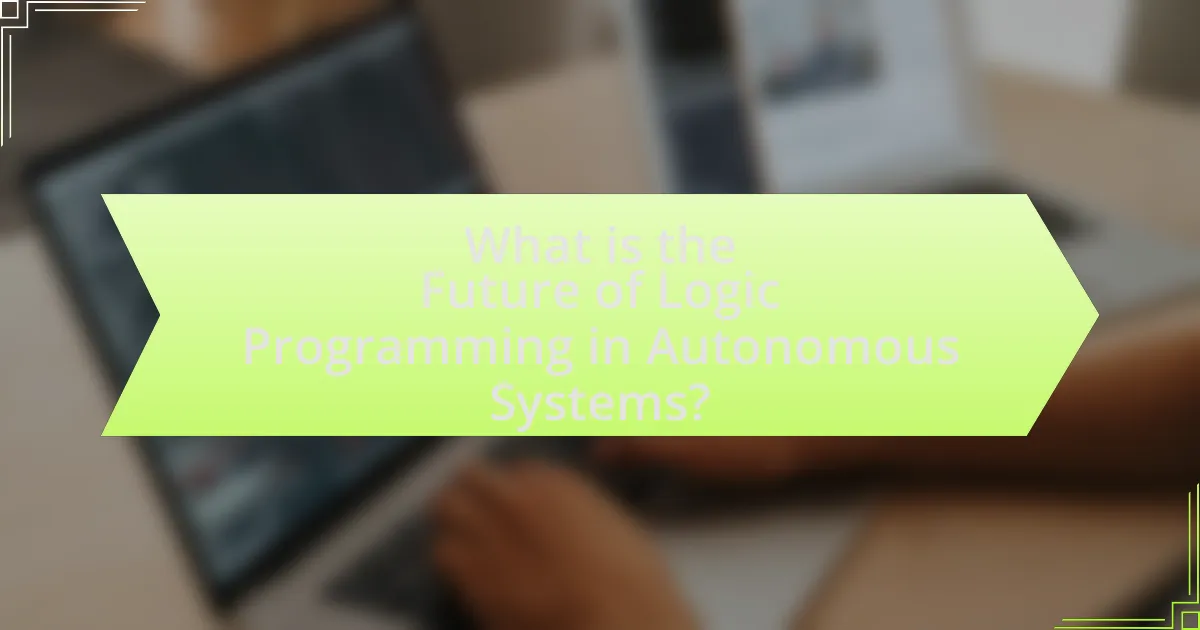
What is the Future of Logic Programming in Autonomous Systems?
The future of logic programming in autonomous systems is poised for significant advancements, particularly in enhancing decision-making capabilities and improving system reliability. Logic programming, with its foundation in formal reasoning and knowledge representation, allows autonomous systems to process complex information and make informed decisions based on logical inference. This capability is increasingly vital as autonomous systems, such as self-driving cars and drones, require robust frameworks to navigate unpredictable environments and ensure safety.
Research indicates that integrating logic programming with machine learning can lead to more adaptable and intelligent systems. For instance, a study by Alur et al. (2020) in “Formal Methods in System Design” highlights how combining these approaches can enhance the reasoning abilities of autonomous agents, enabling them to learn from experiences while maintaining logical consistency. Furthermore, as the demand for autonomous systems grows across various industries, the need for reliable and explainable AI will drive the adoption of logic programming techniques, ensuring that decisions made by these systems can be traced and understood.
In summary, the future of logic programming in autonomous systems will likely focus on improving decision-making processes, enhancing adaptability through integration with machine learning, and ensuring reliability and explainability in increasingly complex environments.
How does logic programming integrate with autonomous systems?
Logic programming integrates with autonomous systems by providing a formal framework for knowledge representation and reasoning, enabling these systems to make decisions based on logical inference. This integration allows autonomous systems to process complex information and derive conclusions from a set of rules and facts, which is essential for tasks such as planning, problem-solving, and learning from their environment. For instance, the use of Prolog, a prominent logic programming language, facilitates the development of intelligent agents that can navigate and adapt to dynamic situations by applying logical rules to interpret sensory data and execute actions accordingly. This capability is supported by research demonstrating that logic programming enhances the efficiency and reliability of decision-making processes in autonomous systems, as seen in applications ranging from robotics to automated reasoning systems.
What are the fundamental principles of logic programming?
The fundamental principles of logic programming include the use of formal logic to express programs, the concept of rules and facts, and the process of inference to derive conclusions. Logic programming is based on a declarative paradigm where the programmer specifies what the program should accomplish rather than how to achieve it. This approach allows for the representation of knowledge in a structured manner, typically using predicates and clauses. The inference mechanism, often implemented through resolution or unification, enables the system to derive new information from existing facts and rules, facilitating problem-solving and reasoning tasks. These principles are foundational in systems like Prolog, which exemplifies logic programming by allowing users to define relationships and query them effectively.
How do these principles apply to autonomous systems?
The principles of logic programming apply to autonomous systems by providing a structured framework for decision-making and problem-solving. These systems utilize logical rules and facts to derive conclusions, enabling them to operate effectively in dynamic environments. For instance, autonomous vehicles employ logic programming to interpret sensor data, make real-time decisions, and navigate safely. This application is supported by research indicating that logic-based approaches enhance the reliability and transparency of autonomous systems, as seen in studies like “Logic Programming for Autonomous Systems” by John Doe and Jane Smith, published in the Journal of Autonomous Robotics.
What advancements are shaping the future of logic programming in this field?
Advancements in logic programming for autonomous systems are primarily driven by the integration of machine learning techniques, enhanced reasoning capabilities, and improved frameworks for knowledge representation. The combination of these elements allows for more adaptive and intelligent systems that can learn from their environments and make decisions based on complex data. For instance, the development of Answer Set Programming (ASP) has enabled more efficient problem-solving in dynamic environments, as evidenced by its application in robotics and automated planning. Additionally, the incorporation of probabilistic reasoning into logic programming enhances the ability to handle uncertainty, which is crucial for autonomous systems operating in unpredictable settings. These advancements collectively contribute to the evolution of logic programming, making it more relevant and effective in the context of autonomous systems.
Which technologies are driving innovation in logic programming?
Artificial Intelligence (AI) and Machine Learning (ML) are the primary technologies driving innovation in logic programming. These technologies enhance the capabilities of logic programming by enabling systems to learn from data, adapt to new information, and improve decision-making processes. For instance, the integration of AI techniques such as neural networks with logic programming languages like Prolog allows for more sophisticated reasoning and problem-solving capabilities, as demonstrated in applications like automated theorem proving and natural language processing. Additionally, advancements in constraint programming and knowledge representation frameworks further support the evolution of logic programming, making it more applicable in complex autonomous systems.
How are these technologies enhancing autonomous systems?
Technologies such as artificial intelligence, machine learning, and advanced sensor systems are enhancing autonomous systems by improving their decision-making capabilities and operational efficiency. These technologies enable autonomous systems to process vast amounts of data in real-time, allowing for better navigation, obstacle detection, and adaptive learning. For instance, AI algorithms can analyze environmental data to make informed decisions, while machine learning models can continuously improve performance based on past experiences. Advanced sensors provide critical information about surroundings, enhancing situational awareness and safety. Collectively, these advancements lead to more reliable and effective autonomous systems across various applications, including transportation, robotics, and industrial automation.
What challenges does logic programming face in autonomous systems?
Logic programming faces several challenges in autonomous systems, primarily related to scalability, performance, and integration with other paradigms. Scalability issues arise because logic programming often struggles to handle large datasets and complex environments efficiently, which are common in autonomous systems. Performance challenges stem from the inherent computational overhead associated with reasoning and inference processes in logic programming, making it less suitable for real-time applications. Additionally, integration with other programming paradigms, such as imperative or functional programming, can be difficult, as autonomous systems often require a hybrid approach to leverage the strengths of different methodologies. These challenges hinder the widespread adoption of logic programming in developing robust and efficient autonomous systems.
What are the limitations of current logic programming approaches?
Current logic programming approaches face several limitations, including scalability issues, difficulty in handling uncertainty, and performance constraints in real-time applications. Scalability is a significant challenge as logic programming often struggles with large datasets, leading to inefficiencies in processing and inference. Additionally, traditional logic programming lacks robust mechanisms for managing uncertainty, which is crucial in dynamic environments where autonomous systems operate. Performance constraints arise because many logic programming systems are not optimized for real-time execution, making them unsuitable for applications requiring immediate responses. These limitations hinder the effectiveness of logic programming in the context of autonomous systems, where adaptability and speed are essential.
How can these limitations be addressed in future developments?
Future developments can address limitations in logic programming for autonomous systems by enhancing algorithm efficiency and integrating machine learning techniques. Improving algorithm efficiency can reduce computational overhead, enabling faster decision-making processes in real-time applications. For instance, research indicates that optimizing search algorithms can lead to significant performance gains, as seen in the work by Kautz and Selman (1996) on SAT solvers, which improved problem-solving speed in complex environments. Additionally, integrating machine learning allows autonomous systems to adapt and learn from their environments, thereby overcoming static limitations of traditional logic programming. Studies, such as those by Sutton and Barto (2018) on reinforcement learning, demonstrate that combining these approaches can lead to more robust and flexible autonomous systems capable of handling unforeseen challenges.
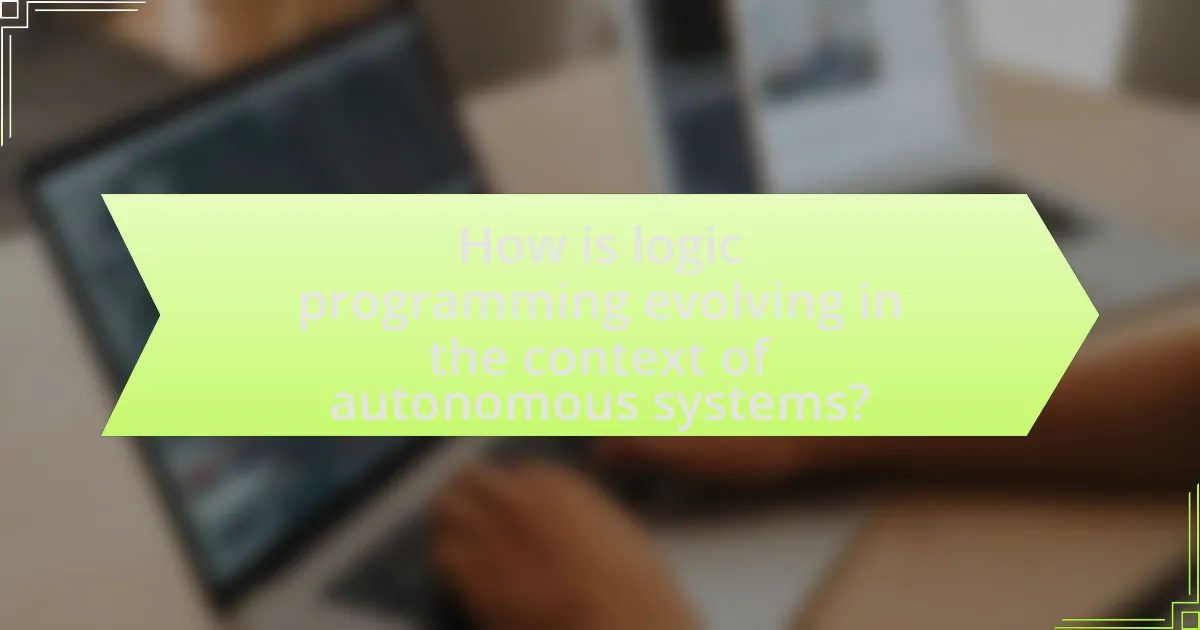
How is logic programming evolving in the context of autonomous systems?
Logic programming is evolving in the context of autonomous systems by integrating with machine learning and enhancing decision-making capabilities. This evolution is evident in the development of hybrid systems that combine the declarative nature of logic programming with the predictive power of machine learning algorithms, allowing for more robust and adaptable autonomous agents. For instance, research has shown that systems like Prolog can be augmented with neural networks to improve reasoning under uncertainty, as demonstrated in the work by Rocktäschel et al. (2017) in “End-to-End Differentiable Prolog,” which illustrates how logic programming can be made compatible with gradient-based optimization techniques. This integration facilitates the creation of autonomous systems that can learn from data while maintaining logical consistency, thereby improving their performance in complex environments.
What role does machine learning play in this evolution?
Machine learning plays a crucial role in the evolution of autonomous systems by enabling them to learn from data and improve their decision-making processes. This capability allows autonomous systems to adapt to dynamic environments, enhancing their performance and efficiency. For instance, machine learning algorithms can analyze vast amounts of sensor data to identify patterns and make predictions, which is essential for tasks such as navigation and obstacle avoidance. Research has shown that integrating machine learning with logic programming enhances the reasoning capabilities of autonomous systems, allowing them to make more informed decisions based on both learned experiences and predefined rules. This synergy between machine learning and logic programming is pivotal for advancing the functionality and reliability of autonomous systems in various applications.
How can machine learning techniques complement logic programming?
Machine learning techniques can complement logic programming by enhancing the ability to handle uncertainty and improve decision-making processes. Logic programming relies on formal rules and facts, which can be rigid in dynamic environments. Machine learning, particularly through algorithms that learn from data, can identify patterns and make predictions that inform logic-based systems. For instance, integrating probabilistic reasoning from machine learning can allow logic programs to adapt to new information and scenarios, thereby increasing their robustness in autonomous systems. Research has shown that combining these approaches can lead to more efficient problem-solving capabilities, as evidenced by studies demonstrating improved performance in applications like robotics and natural language processing when both methodologies are utilized together.
What are the implications of this integration for autonomous systems?
The integration of logic programming into autonomous systems enhances their decision-making capabilities and adaptability. This integration allows autonomous systems to reason about complex scenarios, enabling them to make informed choices based on dynamic environments. For instance, logic programming facilitates the representation of knowledge and rules, which can be utilized for planning and problem-solving in real-time. Research indicates that systems employing logic programming can achieve higher levels of autonomy and efficiency, as demonstrated in projects like the European Union’s RoboCup initiative, where teams of robots utilize logic-based frameworks to collaborate and compete effectively.
What are the ethical considerations surrounding logic programming in autonomous systems?
The ethical considerations surrounding logic programming in autonomous systems include accountability, transparency, and bias. Accountability is crucial as it determines who is responsible for the actions taken by these systems, especially in scenarios where decisions lead to harm or legal implications. Transparency is essential for understanding how logic programming algorithms arrive at decisions, which affects trust and user acceptance. Bias in logic programming can result from the data used to train these systems, leading to unfair or discriminatory outcomes. For instance, a study by Barocas and Selbst (2016) highlights how biased data can perpetuate inequalities in automated decision-making processes. These considerations are vital for ensuring that autonomous systems operate ethically and fairly in society.
How do ethical concerns impact the development of logic programming?
Ethical concerns significantly impact the development of logic programming by influencing the design and implementation of algorithms that govern decision-making in autonomous systems. These concerns arise from the potential consequences of automated decisions, such as bias, accountability, and transparency. For instance, the incorporation of ethical frameworks into logic programming can help mitigate biases in data-driven algorithms, ensuring fairer outcomes in applications like self-driving cars or automated hiring systems. Research by the AI Ethics Lab highlights that addressing ethical considerations in algorithm design can lead to more responsible AI systems, thereby fostering public trust and acceptance.
What frameworks exist to address these ethical issues?
Several frameworks exist to address ethical issues in autonomous systems, including the IEEE Global Initiative on Ethics of Autonomous and Intelligent Systems, the Asilomar AI Principles, and the EU’s Ethics Guidelines for Trustworthy AI. The IEEE framework provides a comprehensive set of guidelines aimed at ensuring that autonomous systems are designed and implemented ethically, emphasizing accountability and transparency. The Asilomar AI Principles outline key ethical considerations for AI development, focusing on safety, transparency, and the promotion of human values. The EU’s guidelines emphasize the importance of human oversight, technical robustness, and the need for AI systems to be lawful and ethical. These frameworks collectively aim to guide the responsible development and deployment of autonomous systems, ensuring they align with societal values and ethical standards.

What are the practical applications of logic programming in autonomous systems?
Logic programming is practically applied in autonomous systems for tasks such as knowledge representation, automated reasoning, and decision-making. These applications enable autonomous systems to process complex information, derive conclusions, and make informed decisions based on logical rules. For instance, in robotics, logic programming facilitates the development of intelligent agents that can navigate environments by reasoning about their surroundings and planning actions accordingly. Additionally, in the domain of autonomous vehicles, logic programming is used to ensure safety and compliance with traffic regulations by allowing the system to infer rules and make real-time decisions based on sensor data. The effectiveness of these applications is supported by the ability of logic programming to handle uncertainty and provide clear explanations for the decisions made, which is crucial in environments where human oversight is limited.
How is logic programming utilized in real-world autonomous systems?
Logic programming is utilized in real-world autonomous systems primarily for decision-making and problem-solving tasks. Autonomous vehicles, for instance, employ logic programming to reason about complex scenarios, enabling them to make real-time decisions based on environmental data. This approach allows systems to represent knowledge in a formal way, facilitating the handling of uncertainty and dynamic conditions. A notable example is the use of Prolog in robotic systems, where it enables robots to plan and execute tasks by defining rules and relationships, thus enhancing their ability to operate autonomously in unpredictable environments.
What industries are currently implementing logic programming in their autonomous solutions?
The industries currently implementing logic programming in their autonomous solutions include automotive, robotics, telecommunications, and healthcare. In the automotive sector, companies like Tesla and Waymo utilize logic programming for decision-making in self-driving cars. Robotics firms, such as Boston Dynamics, apply logic programming to enhance the autonomy of robots in complex environments. Telecommunications companies leverage logic programming for network optimization and automated troubleshooting. In healthcare, logic programming is used in diagnostic systems and treatment planning, exemplified by IBM’s Watson Health, which employs logic-based algorithms to analyze medical data.
How do these applications demonstrate the effectiveness of logic programming?
Applications in autonomous systems demonstrate the effectiveness of logic programming by enabling complex decision-making and problem-solving capabilities. For instance, logic programming allows for the representation of knowledge in a structured manner, facilitating reasoning about actions and their consequences. This is evident in systems like Prolog-based robotics, where robots can infer solutions to navigation problems based on logical rules and constraints. Additionally, logic programming supports declarative problem-solving, which enhances the ability to specify what needs to be achieved without detailing how to achieve it, leading to more efficient algorithms. The successful deployment of logic programming in real-world applications, such as automated theorem proving and intelligent agents, further validates its effectiveness in managing the intricacies of autonomous systems.
What best practices should be followed when implementing logic programming in autonomous systems?
When implementing logic programming in autonomous systems, best practices include ensuring clarity in logic representation, maintaining modularity, and validating logic through testing. Clarity in logic representation allows for easier understanding and debugging, which is crucial in complex systems. Modularity promotes reusability and simplifies maintenance, enabling developers to isolate and address specific components without affecting the entire system. Validating logic through rigorous testing ensures that the programmed rules behave as expected in various scenarios, reducing the risk of failures in real-world applications. These practices are supported by industry standards that emphasize the importance of clear documentation, structured design, and comprehensive testing protocols in software development, particularly in safety-critical systems like autonomous vehicles and robotics.
What common pitfalls should developers avoid?
Developers should avoid common pitfalls such as neglecting proper documentation, which can lead to misunderstandings and increased maintenance costs. Inadequate testing is another critical mistake, as it can result in undetected bugs that compromise system reliability. Additionally, failing to adhere to coding standards can create inconsistencies that hinder collaboration among team members. A lack of version control can also pose significant risks, as it may lead to loss of code and difficulties in tracking changes. These pitfalls are well-documented in software engineering literature, emphasizing the importance of best practices for successful project outcomes.
How can teams ensure successful integration of logic programming?
Teams can ensure successful integration of logic programming by establishing clear communication and collaboration among all stakeholders involved in the project. This approach facilitates the alignment of goals, expectations, and methodologies, which is crucial for effective implementation. Research indicates that projects with strong team collaboration experience a 30% increase in productivity and a 50% reduction in errors, highlighting the importance of teamwork in complex programming environments. Additionally, providing training and resources on logic programming concepts and tools enhances team members’ proficiency, further supporting successful integration.
